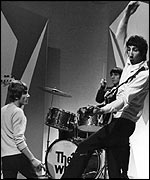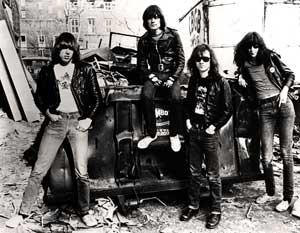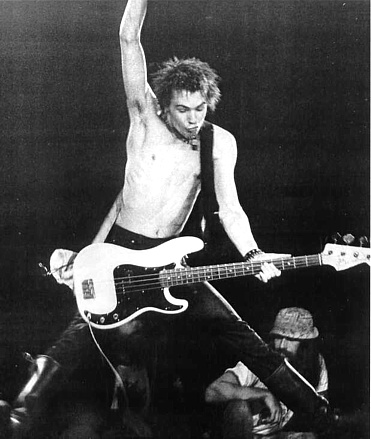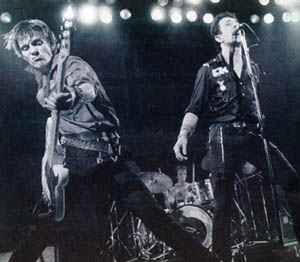|
With
its screeching guitars, crashing drums, and blisteringly critical vocals,
punk has been a staple of the rock and roll world for the past three
decades. Though early punks were shunned by the masses for their loud
music, strange dress, and outspoken political beliefs, the late
nineteen-nineties saw punk rock explode into the mainstream, spawning
several subgenres that continue to dominate modern rock radio. Punk’s
acceptance into popular music is ironic, considering the often caustic and
bitter stance many punk musicians took on the subject. Joe Strummer of the
Clash expresses his disdain for pop in “London Calling,” when he declares
that “phony Beatlemania has bitten the dust”. Despite punk being a
relatively young form of music, it has a rich history, filled with many
talented artists and influences.
In
1971 rock journalist Dave Marsh was the first to use the term “punk rock,”
using it to describe ? and the Mysterians, a band that could hardly be
classified as “punk” using the definition that has emerged over the past
thirty years (Van Dorsten 1990). Nevertheless, the term stuck, becoming
popular among music critics over the next several years, even though at
that point, what many rock historians consider true punk had yet to
emerge.
In
order to pinpoint the origin of punk rock, the structure of the music must
first be examined. Punk songs are often very fast, averaging about two and
a half minutes, though they may be shorter or longer. Punk songs tend to
be in a 4/4 time signature, with significantly faster beats than their
predecessors. Early punks viewed guitar solos as ostentatious displays of
ego; as such, many punk songs lack solos, which were an important element
of the heavy metal acts that begat punk, like Led Zeppelin and Black
Sabbath. Instead, punk guitar parts are usually simplistic, consisting of
power chords with heavy distortion, which creates a rougher, harder sound.
Below the guitar, the electric bass provided much of a song’s momentum,
driving the song forward with an uncomplicated but steady part. The
Ramones’ “Blitzkrieg Bop” is an archetypal punk song, possessing both the
fast, bass-driven beat and simple guitar work. Later bands would begin to
experiment with more complicated bass lines, as exemplified by the Clash,
who incorporated many reggae elements, including more intricate bass
lines, into their music. Punk rock vocals also demonstrated the same sense
of simplicity inherent in the guitar and bass parts. Instead of singing
their parts, punk vocalists tended to shout or yell their lines, resulting
in a hoarse, raw sound, typified by Johhny Rotten of the Sex Pistols.
While the musical elements of punk are integral to examination of the
genre, for analysis of punk’s political effects, no element is more
important than the lyrics. Punk rock’s lyrics range across a myriad of
topics, ranging from traditional rock subjects like love and relationships
to themes far more controversial like sex, drugs, and political dissent.
With
an understanding of the elements of punk rock, determining its origins is
possible. Garage rock bands like the Kinks and the
Who, with
their hard, edgy sound, simplistic chord structure, and harshly critical
lyrics played an important role in
developing
punk’s sound. Indeed, the distortion prevalent in so many punk guitar
lines was originally pioneered by the Kinks’ Dave Davies. (Mendelssohn 40)
In addition to garage
rock, heavy metal had a significant influence on punk. Led Zeppelin’s
“Communication Breakdown” and Black Sabbath’s “Paranoid” demonstrate just how musically
similar punk and metal are to one another, and “Communication Breakdown”
and “Paranoid” both demonstrate the speed and driving bass lines that
would come to characterize punk (Rolling Stone 2004). Among the
less-famous forefathers of punk are Iggy and the Stooges. Formed in 1968,
the band was amateurish, displaying little in the way of musical talent
(Jaffe 1998). However, the lack of innate talent failed to deter Iggy. The
Stooges rose to prominence in the underground scene, with Iggy’s “body
contortions, self mutilation, dives into the audience, and screamed
insults” (Jaffe 1998) drawing far more attention the music. While Iggy and
the Stooges failed to make an impact on the mainstream, they had an
enormous influence on early punk.
However, while all of these groups possessed elements of punk, it would
not be until 1975, with the formation of the Ramones, that punk was truly
born (Jaffe 1998). Hailing from Forrest Hills, Queens, the Ramones
consisted of Jeffry Hyman, John Cummings, Douglas Colvin, and Tamás
Erdelyi, better known by their stage names as Joey, Johnny, Dee Dee, and
Tommy Ramone. The Ramones’ initial lineup included Hyman on drums,
Cummings playing guitar, and Colvin sharing responsibility for both the
bass and vocals. However, once the band began playing together, this
proved impractical, as Dee Dee could not sing and play bass
simultaneously. Joey took over lead vocals, and Erdelyi was added to fill
the vacant drummer’s seat. Though Tommy was the last member of the band to
join, he was their driving impetus for success, even getting them into the
studio for the first time (Laing 2006).
 The
Ramones came of age in a dark era in
United States history. In
1975, the year the band formed,
Saigon fell to Communist invaders from
North Vietnam, ending a long, vicious
struggle. The United States had spent more than a decade fighting a brutal
war in the jungles of Vietnam, only to evacuate its forces as the regime
it had propped up for years utterly collapsed.. In addition to growing up
amidst daily tales of atrocities and destruction from Vietnam, the punk
generation had witnessed chaos and disorder at home. In the late Sixties,
race riots erupted in major urban centers across the country, fuelled by
tensions over the Vietnam War. In 1970, National Guardsmen shot and killed
four protesting students at Kent
State
University in Ohio. By 1974, the Watergate scandal had forced President
Richard Nixon to resign in disgrace. Throughout the entire era, the punk
generation had witnessed the “flower-power” movements of the Sixties wilt,
failing to stop both the war in Vietnam and the violence and social unrest
at home (Zaroulis and Sullivan 1984:401-420) Growing up in this era, the
future punks, Ramones included, were ingrained with an intense distrust of
the government and a cynical contempt for hippies and politicians alike.
As Legs McNeil, co-founder of Punk magazine, stated, “it [the early
Seventies] was a time of change...it confirmed your feeling, this
government sucks, Nixon’s an asshole, and then we had Ford, who was a real
klutz. No one in New York had any money: the city was neatly bankrupt”
(Savage 1992:131). The
Ramones came of age in a dark era in
United States history. In
1975, the year the band formed,
Saigon fell to Communist invaders from
North Vietnam, ending a long, vicious
struggle. The United States had spent more than a decade fighting a brutal
war in the jungles of Vietnam, only to evacuate its forces as the regime
it had propped up for years utterly collapsed.. In addition to growing up
amidst daily tales of atrocities and destruction from Vietnam, the punk
generation had witnessed chaos and disorder at home. In the late Sixties,
race riots erupted in major urban centers across the country, fuelled by
tensions over the Vietnam War. In 1970, National Guardsmen shot and killed
four protesting students at Kent
State
University in Ohio. By 1974, the Watergate scandal had forced President
Richard Nixon to resign in disgrace. Throughout the entire era, the punk
generation had witnessed the “flower-power” movements of the Sixties wilt,
failing to stop both the war in Vietnam and the violence and social unrest
at home (Zaroulis and Sullivan 1984:401-420) Growing up in this era, the
future punks, Ramones included, were ingrained with an intense distrust of
the government and a cynical contempt for hippies and politicians alike.
As Legs McNeil, co-founder of Punk magazine, stated, “it [the early
Seventies] was a time of change...it confirmed your feeling, this
government sucks, Nixon’s an asshole, and then we had Ford, who was a real
klutz. No one in New York had any money: the city was neatly bankrupt”
(Savage 1992:131).
At
the same time, a new musical scene was forming in New York, with clubs in
the Lower East Side of Manhattan, like CBGB’s, playing host to a variety
of “underground” bands. The Ramones excelled in this environment, along
with contemporaries like Blondie, The Patti Smith Group, and the Talking
Heads, all of which would rise to prominence in the later part of the
decade. Based on the strength of their performances in underground clubs,
Sire Records signed the Ramones in 1975. Their debut album, Ramones,
was released soon after (Jaffe 1998).
For
all their success in the New York scene, the Ramones struggled outside of
their home fan base. Never the less, they toured endlessly, ultimately
arriving in the U.K. for a short tour in 1976 where they performed at The
Roundhouse. The Ramones’ frenetic energy and crude style truck a chord
with the locals. A local band called the Sex Pistols had just recently
formed, and the Ramones’ success in England led to a distinct British punk
scene, with the Sex Pistols at its head (Van Dorsten 1990).
The
British punk scene evolved in a very different and distinctive social
environment than the American punk scene. Following the end of the Second
World War, the United Kingdom was in dire straights. It had spent enormous
amounts of capital to finance the war effort, and much of its
infrastructure had been damaged or destroyed at various points during the
war. At the same time, the British Empire was disintegrating rapidly. The
British economy suffered heavily over the next several decades, leading to
high unemployment and an overall dissatisfaction with the British
government (Elbaum and Lazonick 1984:567-583). In addition to a declining
economy, England experienced an immigration boom, with many immigrants
coming from former colonies. The influx of immigrants led to racial
tensions and increased economic strain, ultimately resulting in race
riots. As the economy continued to plummet, the Sixties and Seventies saw
a breakdown in relations between labor unions and the government. Under
both Labour and Conservative governments, labor unions organized massive
strikes, though there was a brief respite in the middle of the
nineteen-seventies. However, by the end of the decade a resurgence of
labor disputes led to an increasingly conservative government, culminating
in the rise of Thatcherism at the end of the decade (Garret 1992:361-365).
The poor economy and the conservative government, along with mounting
racial tensions created an atmosphere of discontent and restlessness that
was ripe for the emergence of punk.
The
Sex Pistols thrived in this new scene, garnering a huge following and
inspiring members of future acts like the Clash. The Sex Pistols became
emblematic of British punk, with their style of performance, dress, and
music setting the tone for the entire punk movement. With their
“nihilistic lyrics…fast paced guitar” (Jaffe 1998) and the antics of
often-intoxicated bassist Sid Vicious, the Pistols gained instant
notoriety.
The
Sex Pistols’ most important contribution to punk was their condemnation of
society. Where the Ramones had sung mostly about the trials and travails
of youth (if negatively), the Sex Pistols were immediately vilified for
their anti-establishment lyrics. Their first album, Nevermind the
Bollocks, Here’s the Sex Pistols, contained two of punk’s most iconic
anthems: “Anarchy in the U.K.” and “God Save the Queen.” In the first,
Pistols vocalist Johnny Rotten brazenly declares “I am an anti-Christ”
before screaming that “anarchy for the U.K., it’s coming soon.” Rotten
caps off the song by urging listeners to “get pissed destroy!”
The
Sex Pistols’ malicious lyrics expressed a discontent that was emerging
among England’s youth at the time. Rallied by the Sex Pistols’ messages,
disgruntled youths flocked to the punk banner, declaring their displeasure
with the increasingly conservative government. However, the Clash would be
the first to clearly express their grievances with society in their music,
rather than conveying only general disapproval of the government.
By
the time the Clash had formed, punk had already produced its own
subculture, complete with a distinctive style of dress. Punks’ appearances
often matched the gritty, unclean sound they produced. Ultimately, the de
facto punk uniform was quasi-military, often with leather jackets
festooned with offensive and crude patches, like Swastikas and upside-down
crucifixes. Below the jackets were equally-offensive t-shirts, studded
belts, and tight jeans, all of which were usually ripped and torn. Surplus
army boots completed the “standard” punk ensemble, creating a militaristic
look that went hand in hand with the anarchist views espoused by many
British punks. As Savage states in England’s Dreaming, “they were
wearing safety pins and ripped-up shirts…with insulting things on them,
White Power logos and swastikas: it was offensive…they meant to distract
people…they were being obnoxious and outrageous” (Savage 1992:135). Many
punks dyed their hair a myriad of colors and experimented with a variety
of hair styles, the best known of which is the Mohawk. Named after a tribe
of Amerindians, the style features a distinctive wedge of hair running
down the middle of the skull, with the scalp on either side being shaved.
The style was extremely popular among punks, as were spiked styles and
shaven heads. It is important to note that the alternative hair styles
were not limited to just men. Women too were known to sport the Mohawk and
other punk hair styles, which led to even greater alienation by mainstream
society (Van Dorsten 1990).
While the Sex Pistols were the main innovators of the British punk scene,
they soon shared the spotlight with many new punk acts. Among the most
famous and influential early British punk bands was the Clash. The Clash
formed not long after the Ramones’ visit to the U.K., but they did not
 become famous in the underground scene until well after the Sex Pistols
(Van Dorsten 1990). The last of the so-called “big three” bands of early
punk, the Clash combined the raw, driving sound of punk with social
conscious lyrics. Songwriter Joe Strummer sang about unemployment, racial
tensions, and government oppression. Their first single, “White Riot”
decried the white population’s compliance with the government’s unfair
policies and subjugation. In the song, Strummer shouts “black man got a lotta problems, but they don’t mind throwing a brick…while we walk the
street, too chicken to even try it.” The Clash achieved massive success
with their 1979 album London Calling, which successfully fused a
variety of international styles of music with punk, creating a sound that
was wholly unique from their punk brethren. On the double-LP, the Clash
continued to criticize establishment, singing about the folly of nuclear
war, the rise of consumerism, and the explosion of racial and economic
tension in urban Britain. The album was a monumental achievement in punk,
and it was hugely successful, both inside and outside of the genre (Laing
2006) become famous in the underground scene until well after the Sex Pistols
(Van Dorsten 1990). The last of the so-called “big three” bands of early
punk, the Clash combined the raw, driving sound of punk with social
conscious lyrics. Songwriter Joe Strummer sang about unemployment, racial
tensions, and government oppression. Their first single, “White Riot”
decried the white population’s compliance with the government’s unfair
policies and subjugation. In the song, Strummer shouts “black man got a lotta problems, but they don’t mind throwing a brick…while we walk the
street, too chicken to even try it.” The Clash achieved massive success
with their 1979 album London Calling, which successfully fused a
variety of international styles of music with punk, creating a sound that
was wholly unique from their punk brethren. On the double-LP, the Clash
continued to criticize establishment, singing about the folly of nuclear
war, the rise of consumerism, and the explosion of racial and economic
tension in urban Britain. The album was a monumental achievement in punk,
and it was hugely successful, both inside and outside of the genre (Laing
2006)
By
the end of the decade, a “second wave” of punk had been launched,
including bands like the Misfits, Black Flag, and the Dead Kennedys. The
style of punk that evolved in the eighties was significantly different
than its predecessor. By this point, there had been some measure of social
reform, and there were new issues for punks to sing about (Blush
2001:12-13). In addition, fueled by the success of the Clash, punk became
more musically diverse, leading to a revival of ska, which is a
reggae-infused brand of punk. With a changing social landscape, punk
ideals changed. The wearing of fascist symbols declined, as punk evolved
to support a staunchly anti-racist stance, embodied in modern times by
acts like Anti-Flag. However, as the nineteen-eighties began to draw to a
close, punk began to lose popularity in the mainstream, and regressed back
to its underground roots as gangster rap emerged from the inner cities to
dominate popular music in the early nineties (Toop 2006). Despite this
decline, the underground scene remained strong, and by the mid-nineties,
modern punk bands like Green Day and the Offspring had surfaced, beginning
a punk revival that has lasted through modern times (Jaffe 1998).
While the punk that exists today is in many ways unrecognizable from the
punk rock of yesteryear, modern punks exhibit the same blatant disregard
for societal norms that their forbearers did as they continue to push the
envelope musically and socially. Modern punk, changed as it may be, is
still a part of the enduring legacy left by the Clash, the Ramones, and
the Sex Pistols.
|